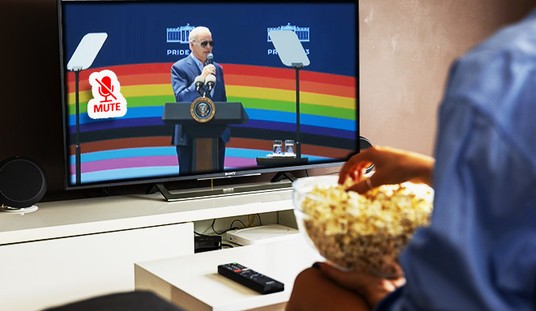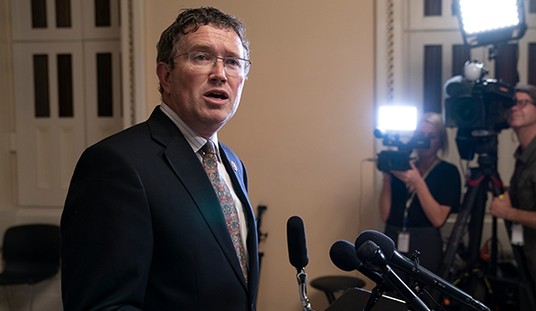In 2004, hundreds of Mormons crowded into the Provo Tabernacle and listened intently as the speaker, who was not a member of the LDS faith, exclaimed, "We have sinned against you."
Was this Bryant Gumbel apologizing for slighting the BYU Cougar's 1984 NCAAF title? No, it was noted evangelical scholar Richard J. Mouw, President of the Fuller Theological Seminary.
In the rush of news articles examining the awkward tension brought about by Pastor Jeffress remarks at the Values Voters Conference is an unnoticed but significant thaw in the troubled relations between Evangelicals and Mormons.
The Big Freeze
Of course, before the thaw, there was the freeze.
The two religious movements share similar roots in the early 19th century revival period. However, while the predecessors of American evangelical proselytizing enjoyed the fruits of their labors across New England unabated, Mormons were being forced westward.
The motives behind the Mormon ouster were generally competitive (the Church of Jesus Christ of Latter-day Saints grew to 100,000 converts in less than 15 years) but also economic (Mormon-dominated Nauvoo, Illinois had a population eclipsing Chicago's in 1844) and certainly cultural.
After the murder of Joseph Smith in 1844 the Mormons left Illinois to find refuge in a desert valley next to a large body of salt water. The parallels to Israel were not lost on the Latter-day Saints who looked to Brigham Young as an American Moses as they founded communities up and down the Wasatch front.
The Saints bore their exile with a certain amount of pride giving little thought to their “brand” in the East as immigrants streamed in by the thousands. Separation had a fermenting effect upon the burgeoning religion as a generation of Mormons raised their children in relative peace.
Recommended
While this first religious rift ended in physical separation the second rift ended in theological banishment from Christendom.
In the 20th century, Evangelical Protestants found huge numbers rallying to the revivalist message of pastors on the lecture circuit. Simultaneously, Mormons left their mountain haven to vie for converts. In 1950 the Mormon Church had over a million adherents. By 1981, Mormons numbered 5 million, with 2 million members overseas.
Suddenly, a good body of literature began to grow up around "cults” – with many tomes focusing on the Latter-day Saints. The impetus for the anti-Mormon movement was based on conflicting theologies. In short, Mormon doctrine doesn't conform with traditional evangelical interpretation of the Bible. While some of these points of contention are genuine chasms (i.e. the nature of God, the notion of an open cannon) other divisions wallow in accusations (e.g. saved by grace or by works).
A Dialogue Begins
In 1996 a very unlikely pair of scholars attempted an unprecedented feat: a book on Evangelical and Mormon beliefs. The "unprecedented" and "unlikely" part is this: one scholar is Evangelical, the other Mormon.
In one corner: Craig Blomberg (Ph.D., Aberdeen), professor of New Testament at Denver Seminary. In the other corner: Stephen Robinson (Ph.D., Duke), professor of ancient scripture at Brigham Young University. Under the traditional rules of engagement, the gloves would come off and the rhetoric would fly long and hard.
Astoundingly, and to the chagrin of many a rhetorical boxer, the book was an attempt at "listening" to the other side, and explaining one's own beliefs. In their book, How Wide the Divide? A Mormon and an Evangelical in Conversation, Blomberg and Robinson tried to dispel common caricatures about each movement that have grown increasingly un-Christian over the previous two decades. Most importantly, the book became the first major dialogue between a recognized Evangelical scholar and his Mormon counterpart.
Soon after its publication, the prominent head of an evangelical organization declared the book to be "an abomination". Evangelical bookstores started boycott efforts. Deseret Book, the Mormon Church-owned publishing powerhouse, pulled its backing from the project which was originally intended to be a joint publication with InterVarsity Press.
Clearly, this was new ground for all the parties involved.
Losing the Battle?
A year later in 1997, two evangelical scholars published an article entitled: "Mormon Scholarship, Apologetics, and Evangelical Neglect: Losing the Battle and Not Knowing It?" In it they examined anti-Mormon literature and Mormon apologetics. What did they find? Well, in their own words:
Mormonism, has, in recent years, produced a substantial body of literature defending their beliefs... In this battle the Mormons are fighting valiantly. And the evangelicals? It appears that we may be losing the battle and not knowing it.
Their purpose in publishing the article was hardly to concede the fight. Indeed, their efforts were "to serve to awaken members of the evangelical community to the important task at hand."
From the Mormon perspective these were unprecedented admissions. Many LDS speak to their frustrations in defending the Mormon Church from debunked century-old attacks. Up until Owen and Mosser, there were very few critiques that had approached Mormon scholarship in a dialogue.
The New Mormon Challenge
Fast forward to 2002, Messrs. Owens, Mosser together with noted conservative author Francis J. Beckwith publish a lengthy volume, The New Mormon Challenge to address the growing movement of Mormonism.
It was within the first paragraphs of the forward that Richard J. Mouw first made the admission of being "ashamed of our record in relating to the Mormon community." As Mormon apologist Dan Peterson noted, the tone is "light years" from the usual garb.
Of course, beyond the courtesy and rapport of the authors are serious disagreements with Mormon theology. "Mormonism's challenges are real and can be dismissed only at a cost evangelicals are unwilling to pay" says Carl Mosser.
The newfound dialogue between Mormons and Evangelicals has left the melee in favor of the gentleman's war. While it can get messy and sticky at times, the general tenor of the battle seems wholly improved and marks a significant thaw in their relations.
For example, in his chapter on Mormon theology, Mosser notes: "One has failed to appreciate Mormonism's distinctiveness if one can classify it as Christian without qualifications." I believe this is a definition that most Mormons would agree with.
And the dialogue continues. Just this month, Stephen Webb, Professor of Philosophy and Religion at Wabash College published an extraordinary article examining the Mormon faith. He writes:
Mormonism can be a controversial topic for many non-Mormon Christians, but I have come to the conclusion that no theology has ever managed to capture the essential sameness of Jesus with us in a more striking way.
The Political Thaw
Of course this is at the academic level. In the political parlor, Mormons have been fervently involved with spreading the conservative “gospel” message.
While The Church of Jesus Christ of Latter-day Saints maintains strict neutrality in regards to politics, Mormons earned serious credibility for their efforts in 2008 to sustain traditional marriage in California and elsewhere. Also, because Utah is a Republican strong-hold, the GOP relies heavily on volunteers from the beehive state to help in battleground electoral votes. One operative told me in 2004 that half of the door-to-door workers in Ohio were LDS.
Other notable Mormon politicos like Glenn Beck and Senator Mike Lee have spearheaded vital elements of the modern conservative movement in the past two cycles.
Prominent activist and pastor Jim Garlow wrote about his experience with the 2008 fight for Proposition 8 in the LA Times: "As evangelicals and Mormons, we are not theological brothers and sisters. But we are friends and neighbors. And on that basis we work together to defend marriage."
Is there discomfort among Evangelicals about Mormons? Yes. Is the breach in the wall large enough where a dialogue can begin in the grassroots? Perhaps. Is it insurmountable? Time will tell.
Will it determine the fate of Mitt Romney? I think not. After all, as someone noted, if common religious bonds were the only yardstick in the voting booth, conservative evangelicals would have chosen Jimmy Carter over Ronald Reagan.























Join the conversation as a VIP Member